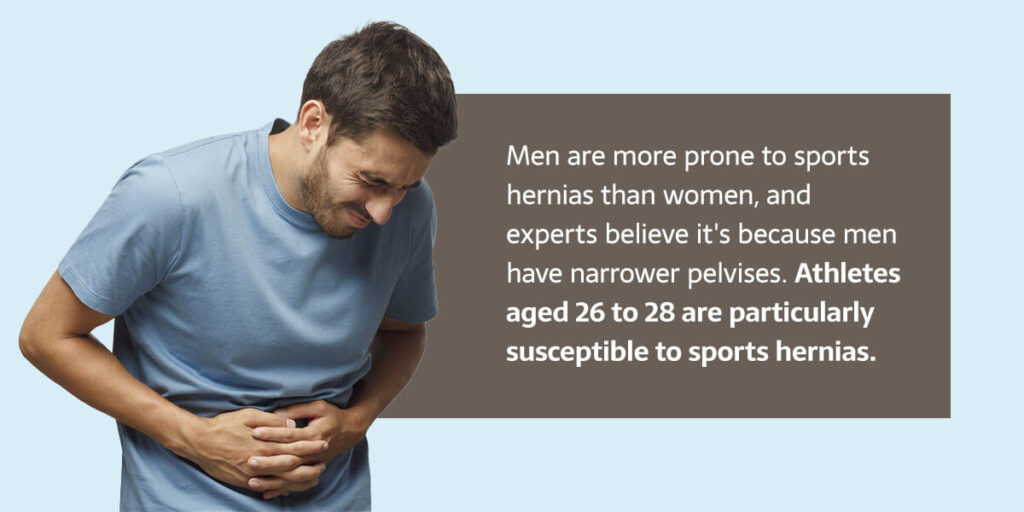How to Tell When You Have a Sports Hernia
How to Tell When You Have a Sports Hernia
If you’re an athlete in a strenuous sport, you’re probably familiar with sports hernias. These injuries are painful and can put you on the sidelines longer than you’d like. Doctors can treat sports hernias with medications, physical therapy or surgery.
If you think you may have developed a sports hernia, read on to learn more about them and how they are treated so you can get back to the game.
What Is a Sports Hernia?
A sports hernia is a wound to a muscle or tendon in the lower part of your abdomen or groin that results in lasting discomfort. Sports hernias are common in athletes of sports that involve changing direction abruptly and extreme twisting motions.
Medical professionals typically refer to a sports hernia as an athletic pubalgia because there isn’t actually a hernia involved. A sports hernia can, however, lead to an inguinal hernia, which happens when tissue pushes through a gap in the lower abdominal wall.
Who Is at Risk for a Sports Hernia?
Athletes of high-intensity sports that demand consistent, strenuous twisting, especially of the pelvis, are most at risk of developing a sports hernia. These motions can cause a strain or tear in the muscles, tendons or ligaments of the abdomen or groin.

Men are more prone to sports hernias than women, and experts believe it’s because men have narrower pelvises. Athletes aged 26 to 28 are particularly susceptible to sports hernias. Children and the elderly rarely develop sports hernias.
Playing the following sports is most likely to result in an athletic pubalgia:
- Football
- Wrestling
- Tennis
- Skiing
- Soccer
- Rugby
- Ice hockey
- Hurdling
You can get a sports hernia even if you’re not an athlete. Anyone who engages in twisting or explosive motions can develop a sports hernia.
What Are Sports Hernia Symptoms?
The predominant symptom of athletic pubalgia is persistent pain in the lower abdomen or groin. The following characteristics apply especially to sports hernias:
- You feel immediate and significant pain when an injury occurs.
- The painful sensation is ongoing and can be burning or dull.
- You notice tenderness or bruising in your upper thigh or lower abdomen.
- You have difficulty determining the exact location in which the pain originates.
- You feel pain in your groin when you sneeze or cough.
- The discomfort travels down to your genitals and/or inner thigh.
- Exerting yourself worsens the pain, especially when running, kicking, twisting or rising up to sit.
- The pain is strong enough that you stop playing your sport or majorly reduce your physical activity.
- The discomfort may dissipate when you rest but returns with physical activity.
How Are Sports Hernias Diagnosed?
Sports hernias can be tricky to confirm because several other injuries and conditions cause similar symptoms. Additionally, injuries to other parts of your body can result in groin pain. Referred pain, as it’s called, happens because your groin contains many nerves that reach different parts of your body.
Your doctor will assess how you’re feeling and review your history before conducting a thorough physical exam. They may also use diagnostic imaging to help confirm or rule out an athletic pubalgia.
Imaging tests may include:
- Magnetic resonance imaging (MRI): MRIs use a large magnet, radio waves and a computer to produce clear images of the structures within your body. MRIs are the most effective scans for identifying tears in soft tissue.
- X-ray: X-rays use safe amounts of radiation to create pictures of your bones and soft tissues.
- Ultrasound: Ultrasounds use sound waves to display real-time images of your organs and soft tissues.
- Computed tomography (CT) scan: CT scans use X-rays and a computer to create detailed pictures of a cross-section of your body.
- Bone scan: Bone scans use a radioactive isotope injection in your arm to help detect abnormalities in your bones.
How Are Sports Hernias Treated?
The goal of treatment is to relieve your pain, restore your strength and functional movement and get you back to playing your sport.
Treatment plans for sports hernias depend on a few factors, such as the gravity of your injury, your age, your health status and the level of physical activity you wish to regain.
Doctors treat sports hernias using non-surgical or surgical methods. Your doctor will likely recommend non-surgical methods first before turning to surgical procedures.
Non-Surgical Treatment
Non-surgical treatments for sports hernias include the following:
- Rest: Taking a break from vigorous physical activity and icing your injury during the first 10 days can help.
- Compression: A wrap or compression garment can help reduce pain if you have a bulge in your lower abdomen or groin.
- Anti-inflammatory medications: Non-steroidal medications like naproxen and ibuprofen can help ease swelling and discomfort.
- Corticosteroids: Your doctor may suggest steroid injections if your symptoms persist.
- Physical therapy: Physical therapy beginning two weeks after your injury can help improve the strength and flexibility in your lower abdomen and groin.
Surgical Treatment
Your doctor will turn to surgical treatment methods if your symptoms do not improve after six months of non-surgical treatment.
Surgical procedures for sports hernias include:
- Open surgery: Your surgeon will cut open your skin and tissues to visualize the area they will work on.
- Laparoscopic surgery: Less invasive than open surgery, laparoscopic surgery uses a camera inserted through a small cut to help the surgeon visualize the problem area. He will then insert small surgical tools through additional cuts to make the repair.
A material made of mesh is frequently used in both surgical approaches to reinforce the damaged tissues. However, the body may not react favorably to foreign material. Mesh can cause infections and scar tissue, resulting in pain and other serious complications that may require additional surgery.
Fortunately, many patients are eligible for no-mesh hernia surgery. You may not need mesh if you have healthy tissue surrounding the hernia. Your surgeon can use sutures to bring the healthy tissue together and cover the hernia. There are many benefits of no-mesh hernia repair, like decreased risk of complications and faster rehabilitation following surgery.
Turn to U First Health for Sports Hernia Treatment
The doctors at U First Health in Fort Myers, Florida, are revolutionizing hernia repairs with mesh-free surgical techniques. As the Desarda Hernia Center of the United States®, we offer an intimate, concierge-style experience and an on-site surgical suite to streamline your hernia treatment. If you’re looking for approachable, compassionate providers and a seamless treatment plan for your hernia, you will find it at U First Health.
Give us a call at 888-884-0019 to learn more, or contact us to schedule an appointment.
